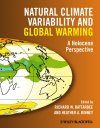Edited By: Richard W Battarbee and Heather A Binney
276 pages, Col & b/w figs, b/w illus
![Nature Climate Variability and Global Warming Nature Climate Variability and Global Warming]()
Click to have a closer look
About this book
Contents
Customer reviews
Biography
Related titles
About this book
A growing body of scientific evidence suggests that greenhouse-gas pollution is largely responsible for global warming. Yet, it is also true that the climate system varies quite naturally on different time-scales. Accurately predicting the course of future climate change requires an understanding of the natural variability of the climate system, as well as the effects of human-induced change. This ground-breaking text addresses predictable modification in the climate system in the context of global warming. Ideal for researchers and advanced students, it explores current thinking on natural climate change, the use of models to simulate past climate variability, and the role of past climate variability in explaining current changes to ecosystems and society over the later part of the Holocene. This important volume provides the groundwork for making critical decisions about the earth's future, and contributes substantially to the ongoing debate over global warming and climate change.
Contents
1. Holocene climate variability and global warming. Richard W. Battarbee2. Holocene climate research - progress, paradigms, and problems. H. John B. Birks3. The role of people in the Holocene. Frank Oldfield4. Modelling the climate of the Holocene. Michel Crucifix5. The early to mid-Holocene thermal optimum in the North Atlantic. Eystein Jansen, Carin Andersson, Kerim H. Nisancioglu, Birgitte F. Nyland, and Richard J. Telford6. Holocene climate change and the evidence for solar and other forcings. Juerg Beer and Bas van Geel7. Climate of the past millennium: combining proxy data and model simulations. Hugues Goosse, Michael E. Mann and Hans Renssen8. Latitudinal linkages in late-Holocene moisture-balance variation. Dirk Verschuren and Dan Charman9. Holocene rapid land-cover changes - evidence and theory. Martin Claussen10. Holocene perspectives on future climate change. Ray BradleyIndex
Customer Reviews
Biography
Rick Battarbee is Professor of Environmental Change and Director of the Environmental Change Research Centre at UCL. He is a Fellow of the Royal Society and a Foreign Member of the Norwegian Academy of Science and Letters and was the Chair of the European Science Foundation program "HOLIVAR." Heather Binney is a Research Fellow in the Environmental Change Research Centre, UCL. She is a palynologist with a special interest in pollen-vegetation relationships.
Edited By: Richard W Battarbee and Heather A Binney
276 pages, Col & b/w figs, b/w illus
Volumes such as this provide the historical contexts and broad overviews needed to advance climate change biology toward broader conceptual developments and synthetic methodologies for understanding and predicting climate change effects, as well as developing effective adaptation and mitigation strategies.. (The Quarterly Review of Biology, 1 December 2010) “This is an important book for understanding climate changes in a longer perspective." (Geologos, 2010) “This book brings together some of the most prolific names in their field to create a sound and interesting look into this area." (The Environmentalist, November 2009) “It highlights the need to improve not only our understanding of the physical system through time but also our knowledge of human influence on the climate system and vice versa." (Bulletin of the American Meteorological Society , April 2009) “Although aimed at ‘researchers and advanced students', this layman found the book perfectly accessible." (Geoscientist, August 2009) "The rapid climate change that seems to be occurring world-wide make this volume both timely and instructive, concentrating as it does on the Holocene period... An essential addition for an meteorological library." (The International Journal of Meteorology, April 2009) The Holocene, the interval covered by the last 12,000 years, represents a largely nonglacial period in Earth's climatic evolution. This book synthesizes the climate history of this interval and investigates the role of natural climate variability in explaining current global warming. The volume contains ten chapters written by experts in various aspects of past climate change. Chapter 1 provides a short introduction and outlines the objectives/contents of subsequent chapters. The next chapter, the longest (51 pages), considers the progress, paradigms, and problems in Holocene climate research. Chapter 3 addresses the fundamental question of the human role in the changing climate of the Holocene while acknowledging that climate change itself has strongly impacted the history of civilizations. Our ability to predict future climate depends on our ability to reconstruct and model what has already happened; chapter 4 explores this vital issue. Subsequent chapters examine some relevant intervals including the so-called Holocene thermal optimum, and evaluate and model what natural processes might have contributed to observed climate histories. The final chapters assess rapid land-cover change and analyze future climate change within the perspective of the last 12,000 years. Includes chapter references, an eight-page index, and a three-page summary of abbreviations and dating conventions. Summing Up: Recommended. Graduate students, researchers, faculty, professional audiences. -- J. T. Andrews, University of Colorado at Boulder (Choice, February 2009)


































